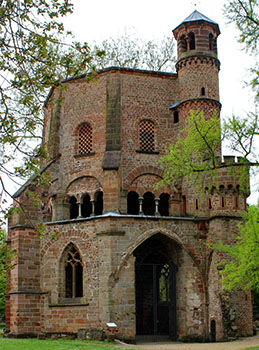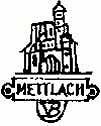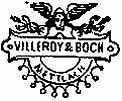
This article is intended as an adjunct to the on-line Mettlach Stein Catalog in the Beer Stein Library. Clicking on any of the various links provided herein will produce a separate window displaying the catalog listing associated with the item cited in the text.
 |
Located on the Saar River in western Germany, close to borders with Luxembourg and France, the Mettlach factory is housed on the grounds of a former Benedictine Abbey dating to the 10th century. The factory was founded on this site in 1809 by Johann Franz Boch-Buschmann, and the company of Villeroy & Boch resulted from a merger with Nicolas Villeroy in 1836.
Each of several V&B factories designed (and trademarked) their own wares, and while other factories admittedly produced some high quality and desirable steins, this article will deal exclusively with those manufactured at Mettlach. Further, while Mettlach produced plaques, pokals, beakers, punch bowls, pitchers, tobacco jars, vases, dinnerware, ash trays, beer taps, candlesticks, bottles — the variety seems endless — this article will stick with beer steins.
The Attraction for Collectors
Mettlach steins have a number of characteristics which make them a perfect collectible:
� they are well-marked and easily identified;
� good reference works are available;
� there are many related pairs and sets;
� designs are original and creative;
� broad variety allows for every taste;
� excellent quality control was maintained;
� there is a ready market;
� prices have been broadly stable.
No one knows how many steins were produced by Mettlach, but we do know that at the height of production Mettlach employed over 1250 factory workers alone. Allowing for different sizes and design variations, the on-line Mettlach Stein Catalog lists over 1600 different steins! Gary Kirsner, author of The Mettlach Book, speculates that average production could have exceeded 2000 examples, noting that the most items certainly had far more, while some had far less.
While we might be tempted to speculate that the majority of this production remains in Germany, this is a very shaky conclusion. In addition to normal breakage over time, huge quantities of these examples of German culture were intentionally destroyed by conquering forces after each of the two World Wars. Mettlach wares became well known in the U.S. following exhibitions in Philadelphia (1876) and Chicago (1893), and U.S. collections provided a safe haven during the war years. As a result, a significant portion of the existing Mettlach pieces are in the U.S.
More important to today’s collector than the original production quantities is the quantity which remains intact. Although in a few cases only one or two examples are known, the majority of items are more common, with somewhere between 100 and 500 examples being seen on the American market.
Types of Steins
The primary “lines” of steins produced by Mettlach are briefly described in the following sections. While reference is made to production techniques, it must be pointed out that Mettlach used many different techniques which were refined over time, and likely altered these techniques in producing specific items. Much research has been done to try to understand how Mettlach produced these items, and each of the theories is able to produce evidence to support it.
While the various categories of Mettlach steins and their markings are discussed below, it should be noted that the stein type is the primary characteristic by which all steins are known. Thus collectors refer to “old style,” relief, etched, cameo, PUG, etched and PUG, etched and relief, character, faience, Rookwood, Delft, etc. Note that these terms refer to the decoration on the stein, including the side decorations, but ignoring any framework surrounding the decoration as well as the rim and base ornamentation.
“Tree-Trunk” Relief
The early (pre-1880) stein production by Mettlach was generally limited to a relief “tree trunk” style, where the body was molded with the appearance of a tree trunk, and leaves and vines were added in relief. These steins, also called “old style,” were frequently highlighted with shiny platinum. (See, for instance Mettlach No. 216.) Comprising a very small fraction of the total stein production of Mettlach, these early pieces are largely ignored by collectors.
The construction of a railroad along the Saar River, together with new production techniques and an emphasis on the best artistic standards of the past, allowed Mettlach to introduce several new lines in the years following 1880. These wares, featuring extensive use of color, were termed “frankly unrivaled” at the 1885 World’s Fair in Antwerp, bringing Mettlach worldwide renown and stimulating vigorous production.
Etched or Chromolith
The most noteworthy innovation during this period was the introduction of what we today call “etched” steins, and it is this line which led to the acclaim and popularity which Mettlach enjoyed. The term “etched” derives from the look and feel of the decoration, where the outline and details of the design are formed by incised black lines. These lines can easily be felt by fingertip or fingernail. The design was made from colored slips of clay, which are separated and given detail by the incised lines. These lines are actually formed by mold (although the exact technique has been the subject of much research and speculation), and no “etching” of the surface was actually involved. The most common and most popular themes for etched steins include scenic illustration — tavern scenes, castles, the Munich Child, medieval scenes, etc. However, a number of steins were made with abstract designs, and these are generally known by another name. “Art Nouveau” steins feature the flowing lines and geometric patterns of that style, and “Mosaic” steins involve a repeating pattern comprised of many small sections of colored clay. These distinctions are strictly ones of decorative style.
Relief
At about this same time, Mettlach began to introduce relief steins using either applied or molded relief decoration. The decoration was typically light in color against a darker color on the body (frequently blue or terra cotta). (See, for instance, Mettlach No. 1266.) In the case of applied decoration, the color was achieved by using a different coloration in the clay itself. In other cases it appears that the color was introduced by setting the design in the mold using one color, and then adding the clay for the body. These steins are similar in appearance to Wedgwood Jasperware, although of higher quality and finer detail. A later innovation involved the use of full color relief decoration (Mettlach No. 1756, for example), but the production of relief steins never approached the volume of etched steins.
Cameo
Similar in initial appearance to relief items, cameo steins utilize a more translucent material for the design, and exhibit a finer degree of detail, achieving an appearance similar to shell cameos. Whereas relief steins are commonly glazed, the cameo decoration is unglazed, or bisque. The two lines also used different background colors, with the cameo items using a sea-green or dark blue unglazed background which heightens the translucent feel of the decoration. (See, for instance, Mettlach No. 2652.) Cameo steins were given form numbers in the 2000s and 3000s.
Print Under Glaze (PUG)
In 1886 Mettlach initiated use of a transfer technique for decorating a less-costly line of products based upon a process employed by the English. This involved the use of lithographed designs on metal plates, which then transferred the full-color design to a paper “transfer.” The stein body was first glazed and fired. The transfer was then applied, followed by another clear glaze and final firing. There are also a number of Mettlach PUG steins on which the transfer consisted of only an outline of the design, and the colors were handpainted. Unlike other Mettlach lines, PUG decorations are flat on the body and smooth to the touch, and the steins have a glossy glaze finish. Because they required significantly less handwork, the simple half-liter PUG bodies originally cost about one-third as much as the half-liter etched bodies, although with the addition of a pewter lid they were about half as costly. Interestingly, the pewter lid for a simple half-liter PUG cost more than the body alone!
The use of transfer decoration meant that a unique mold was no longer required. A large variety of decorations were applied to the same body form number. Forms 1526 and 1909, in both ½-liter and 1-liter sizes, were the most commonly used (see, for example, Mettlach Nos. 1526/588 and 1909/702), although there were many others. In some cases, the same design was used on more than one body.
As may be discerned from the two previous examples, whereas etched and other types of steins are generally known by the form number, PUG steins are known by the combination of decoration number followed by form. As an example, a PUG stein with body form 1526 and decoration number 588 will be commonly referred to as “1526/588”.
At various times, Mettlach produced steins which had the same decorative style as other manufacturers or periods, including Delft designs, faience and Rookwood. The Mettlach “Rookwood” steins were similar in general appearance to standard-glaze portrait items produced at the Rookwood factory in Cincinnati, Ohio. The outline of the decoration for these items was put on the body using a printed transfer, and the decoration was finished by hand. The Mettlach Rookwood steins, all of which are portraits, were made with a fancy “carved” pewter lid, many with a large ball thumblift, reminiscent of lids from an earlier period. Many of the faience and Delft steins also came with these lids, and some of the faience steins included a pewter footring.
Special Orders
Mettlach produced many steins to special order, for both domestic purposes and for export. In fact, many steins bearing German phrases or verses can also be found in an English-language version. While we might suppose that it would be prohibitively costly, the existence of a sizable number of such pieces indicates that it was not. Well-known examples of special orders include an etched stein for St. Augustine, Florida, which includes a figural alligator handle, three steins produced for Cornell University, and the Quilmes Brewery (Argentina) steins.
Handpainted Steins
True handpainted designs were used for many custom decorated steins, and they frequently carry silver presentation lids. While some of these may have been decorated in the factory, more commonly they were commissioned to local artists who worked on either flat or relief matte-finish bodies especially purchased for this purpose. Although there are a wide variety of hand-painted themes, the most common examples are probably steins decorated with student crests or wappen. These steins are frequently marked on the base or on the rear of the body to identify the decorative firm.
Sizes
While the vast majority were � or 1 liter in capacity, Mettlach produced steins ranging in size from 0.05 liter (very few, Pug decorated) to 7.0 liters (only one, Mettlach No. 1161). This etched giant stands 21" tall and weighs about 11 pounds — empty. With a figural stoneware inlaid lid, this stein cost 40 DM in 1885, making it the most expensive stein offered by Mettlach. The body without a lid cost 30 DM, for which sum one could purchase 7 or 8 smaller etched steins with inlaid lids.
Lids
Most collectors today feel that without a lid, a stein is incomplete. This is especially true for Mettlach, since a very large number of the steins had stoneware inserts (inlays) in a pewter ring designed to match or complement the body. While Mettlach steins could originally be ordered without lids, those steins were in the clear minority.
The various types of lids originally accompanying Mettlach steins include figural (three-dimensional), etched inlay, PUG inlay, fancy pewter, simple domed or low-relief pewter (the most common lids on PUG steins) and presentation lids (usually silver or silver-plated and probably added to a specially ordered lidless piece). Etched steins bore either etched inlaid lids, figural lids or pewter lids. Mettlach’s Occupational Series provides excellent examples of etched lids which complement the themes on the bodies of the steins. PUG steins were made with either PUG inlays or pewter lids. While pewter lids were more expensive and more prized than many of the stoneware inlays during the height of Mettlach production, that appeal has been reversed for modern collectors.
Mettlach Artists
Mettlach employed a large number of artist/designers, including some of the most prominent of their time. Most prolific among them were Heinrich Schlitt, Otto Hupp, Fritz Quidenus, Christian Warth, Johann Baptist Stahl, and M. Hein. Other notable artists who designed steins for Mettlach include Ludwig Hohlwein, Franz Ringer and Richard Riemerschmid. A large number of steins, although still the minority, carry the name or initials of these artists as a “signature.” Many unsigned steins can still be attributed to the artist who conceived of their design. The works of Heinrich Schlitt, a very famous Munich artist who designed murals in many public facilities, are a favorite of Mettlach collectors. Many of his works feature Heinzelm�nnchen, the German “mystery people,” or fun-loving dwarfs. The steins designed by Ringer, Hohlwein, Hupp and Riemerschmid are also highly coveted by collectors for their artistic execution.
Recognizing Mettlach Steins
 |
 |
Distinctive shapes of Mettlach numerals can help in identification. In addition to a trademark, several other markings typically appear on the base of Mettlach steins, the most important being a three- or four-digit incised form number, and in the case of the PUG, Delft and Rookwood steins, a stamped decoration number. Other marks include a Roman numeral indicating the size, a two-digit number indicating the year, and various quality-control marks. Steins manufactured for export may also be marked “Made in Germany,” or even “Reg. U.S. Pat. Off.”
 |
Mettlach, one of several factories of the Villeroy & Boch ceramics company, was the most prodigious of all stein manufacturers between 1885 and 1910, sometimes called “the golden age of beer steins.” Their wares are readily identifiable by quality, style and artistry, as well as by very thorough base marking. Steins were produced in a variety of different lines, including the following:
“Old Style” — applied relief, frequently tree-trunk motif, used platinum highlights;
Etched — full color, normally matte finish, detailed designs where the design is flat but detail and color separation is provided by incised black lines;
Relief — the primary design is presented in relief in one color against a contrasting body color, or later, a full color relief design;
Cameo — similar to relief, but the decoration is an unglazed, translucent porcelain-like material against a sea-green or dark blue background (form numbers in the 2000s);
PUG — the design, made from a printed transfer under the glaze, is smooth to the touch and has a shiny finish, the design number should be stamped on the bottom of the stein along with the incised mold number (the most common mold numbers are 1526 and 1909).
The name Mettlach would not be nearly so well known were it not for the artistic merit and the consistently high quality of their wares. It is not a coincidence that the manufacturer with the best designs and the best production techniques was also the most prolific producer of beer steins. The large volumes produced by Mettlach, the variety of decorative themes and techniques, the number and quality of the artists they employed, the willingness to experiment and their continual innovation — both artistic and technical — give ample warning: while we can analyze and theorize to great lengths, Mettlach broke more rules than they followed, and new examples continue to surface.
**********
References
Kirsner, Gary, The Mettlach Book, Glentiques Ltd., Coral Springs, FL, 1987
Prosit, quarterly publication of Stein Collectors International, 1965 to present (numerous articles displaying growing knowledge and theories about Mettlach wares, techniques and artists).
Thomas, Dr. Therese, and Anton Post, Mettlach Stoneware 1885-1905, Hans J. Ammelounx, Wheeling, IL, 1975
Thieler, E. R., Making Steins in an Old Monastery, booklet reprinted by Stein Collectors International, 1971
KERAMIK 6, Buchverlag J. Büchel, Triesen/Lichtenstein (German and English)
__________
© 1997-2002 Beer Stein Library — All rights reserved.